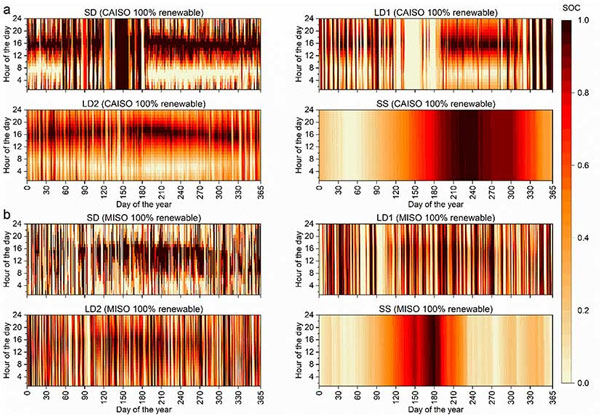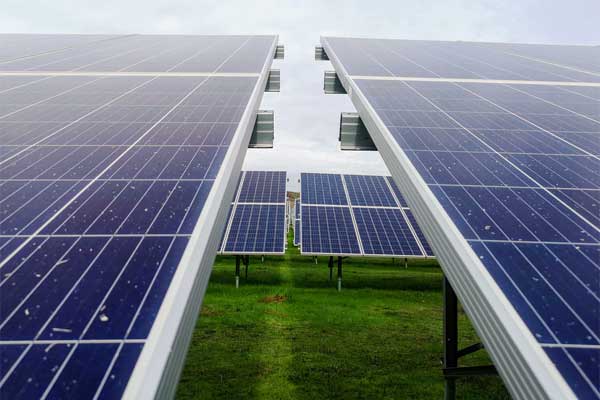- Findings from the study are imminently important for system operators, technology developers, power providers, and the wider industry.
- The chief message for these groups is that an ideal energy storage portfolio could look significantly different from one region to the next and will vary with the percentage of renewables.
As states reach higher toward 100% renewable operation, energy storage will be key to enabling a more variable power supply. But no single technology will be a silver bullet for all our energy storage needs.
Rather, a portfolio of storage solutions makes best economic sense for future energy systems, according to a recent National Renewable Energy Laboratory (NREL) analysis titled “Optimal energy storage portfolio for high and ultrahigh carbon-free and renewable power systems,” published in Energy & Environmental Science.
“The fact is, every energy system is different, with different demand, renewable deployment, weather, etc.,” said Omar J. Guerra, NREL researcher and lead author on the paper. “We have found that energy storage enables the lowest cost of energy across different timescales and economic circumstances on high-renewable systems, which means we are looking at a combination of storage technologies for the future grid.”
Storage technology trade-offs
Guerra and researchers Joshua Eichman and Paul Denholm used a custom high-resolution optimization model to compare energy storage combinations across the United States. The researchers found that geographic variation, among other factors, can drastically shape an energy storage portfolio.
For example, the California Independent System Operator (CAISO) grid is solar-driven, discharging seasonal storage for around 50 days to cover winter months in the model, whereas the wind-driven Midcontinent Independent System Operator (MISO) could deploy shorter-duration seasonal storage (but still much longer than most currently deployed storage technologies) with capacity of 5–14 days.
The storage technologies face fundamental trade-offs in efficiency and capital costs for both the power and energy component, which is exactly why multiple technologies are useful. Short-duration (intraday) storage like Li-ion batteries have higher efficiencies but also high energy-related costs, while longer-duration (daily) storage like compressed air or pumped thermal have lower energy-related costs but are less efficient.
“With very high or 100% renewable power systems, we need to be conscious of what storage mix is best for which locations or systems. The costs, including costs of avoided CO2 emissions, vary substantially with choice of storage portfolios,” Guerra said.
Storage portfolio for 100% renewables
The researchers produced some surprising results for ultrahigh renewable systems: As a system approaches 100% renewable operation, an increasing portion of its storage portfolio would benefit from multiple-day to seasonal storage capacity. This is because of the increasing seasonal mismatch of the remaining load and the supply of renewable resources. However, on a grid-like CAISO, shorter-duration storage is more effective at smoothing the diurnal swings of solar.
As seasonal storage becomes a bigger player when nearing 100% renewable systems, another surprising strategy appears in which storage-to-storage charging becomes economically advantageous. And, as a result, renewable curtailment begins to drop because more of the renewable power can be directed to storage. These dynamics for ultrahigh renewable systems highlight how competing factors can widely affect an optimal storage portfolio.
Impact on power industry
Findings from the study are imminently important for system operators, technology developers, power providers, and the wider industry. The chief message for these groups is that an ideal energy storage portfolio could look significantly different from one region to the next and will vary with the percentage of renewables. As more cities and states set clean-energy targets, stakeholders that are planning 10 or 20 years ahead should be tuned-in to the broader energy storage technology space and how it fits into their systems.
What is next?
Now that the researchers have established substantial cost differences in storage deployments, future work will focus on a more comprehensive assessment of the value of storage.
“We need a more holistic approach,” Guerra said. “Storage technologies are very flexible and can be used for a variety of grid services. Our next step will be to understand the full range of energy storage benefits to inform optimal storage portfolios.”
—
Publication Referenced in the Article:
Omar J. Guerra et al, Optimal energy storage portfolio for high and ultrahigh carbon-free and renewable power systems, Energy & Environmental Science (2021). DOI: 10.1039/D1EE01835C
—
This article was written by the Department of Energy’s National Renewable Energy Laboratory.











Comments